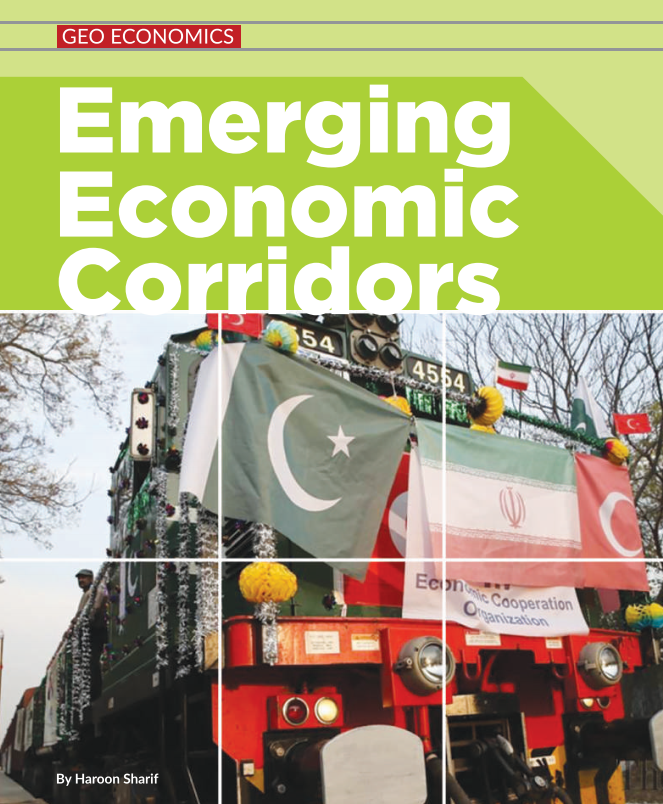
By Haroon Sharif
China’s flagship BRI and CPEC have laid solid foundations for emerging regional connectivity. The success of CPEC as a transformational investment is critical for both China and Pakistan to demonstrate their ability to steer this region towards a sustainable growth path.
Despite increased political intensity and geopolitical shifts in 2021, the momentum of global economic gravity continues to shift towards China and East Asia in 2022. The contours of a new economic and political geography within South Asia are also becoming visible with enhanced connectivity among western China, Pakistan and and Central Asia.
Led by China’s Belt and Road Initiative (BRI), this fascinating transition is already having a remarkable influence on the thinking patterns, politics, cultures and economic developments in this region. For a region that has remained in the grip of internal and geo-political conflicts for years, it is perhaps the opportunity to leverage its potential for economic prosperity, stability and human development.
These changing times certainly pose a big challenge to both public and private sector leaders to get out of their historical baggage and start capitalizing on new economic opportunities and models of engagement within the region for the next many years to come. Renowned historian Peter Frankopan reminds us that although many of us think globalization as a fairly modern phenomenon, yet 2,000 years ago, it was a fact of life, one that presented opportunities, created problems and prompted technological advances. It is pertinent to note that after the booming times of the old silk route, these emerging new economic corridors are once again driven by the dynamics of economic proximity rather than a security led paradigm.
China’s flagship BRI and the strategic China Pakistan Economic Corridor (CPEC) have laid solid foundations for emerging regional connectivity. The success of CPEC as a transformational investment is critical for both China and Pakistan to demonstrate their ability to steer this region towards a sustainable growth path. Pakistan is struggling to design and implement structural reforms to increase its institutional capacity for maximizing the CPEC outcomes for the benefit of its over a hundred million young labour force.
“Pakistan is struggling to design and implement structural reforms to increase its institutional capacity for maximizing the CPEC outcomes for the benefit of its over a hundred million young labour force.“
In 2022, the government needs to fast track completion of Specialized Economic Zones (SEZ) and focus industrial cooperation priorities. In the long run, CPEC should not be seen merely as infrastructure investments, it must reflect President Xi’s vision of tackling corruption, cleaner environment and uplifting the quality of life for the marginalized. For Pakistan, three areas of structural reforms need urgent attention for managing this extraordinary transition. Firstly, Pakistan will have to strengthen the structure and orientation of its bureaucracy towards a pro-growth system.
The existing system has little understanding of the already changed and continuously evolving global economic landscape. For instance, several countries have taken progressive steps in this direction by merging trade and foreign policy objectives. Secondly, there is a need to mainstream the role of private sector in the new economic diplomacy where geographical proximity will have a central role. The country should be willing to let go the inefficient sectors which have flourished on patronage and state protection. Pakistan’s global competiveness has deteriorated over the past couple of decades when compared with its peers.
The old school of import substitution and protection to local industrial base has stagnated the growth potential as such firms will never be able to compete with emerging Asia. If a level playing policy environment is created, the private sector can enhance productivity and ensure job creation by being part of the regional value chains. Thirdly, investment in regional knowledge networks will be crucial to sustain Pakistan’s key position in the new regional markets.
Pakistan must benefit from China’s phenomenal research and development expertise in all spheres and link up its universities and think tanks with south and west Asian neigbours. It is the exchange of skilled youth which will generate ideas and strengthen the regional integration for shared growth and stability.
“Pakistan must benefit from China’s phenomenal research and development expertise in all spheres and link up its universities and think tanks with south and west Asian neigbours. It is the exchange of skilled youth which will generate ideas and strengthen the regional integration for shared growth and stability.“
With the improvements in connectivity infrastructure, bilateral trade between China and Pakistan is growing and stood at $17.49 billion in 2020. Pakistan recorded nearly 70% increase in exports to China in the first quarter of 2021 with $888 million as compared to $526 million in the same period. The projected potential of bi-lateral trade between the two countries is $100 billion.
However, in order to realize this goal, Pakistan will have to increase its per capita income, productivity and quality of exportable goods to meet international standards. Human resource development will play the most crucial role if real benefits of regional connectivity are to be realized with a visible impact on the lives of the poor. The current structure of skills training will have to be shifted from efficiency based to knowledge based skills to reap benefits of the fourth industrial revolution.
The recent rather abrupt withdrawal of the US led coalition from Afghanistan needs to be seen in a wider context of the transformational regional transition led by China. With over forty years of conflict and geo-political power play, Afghanistan’s situation remains a binding constraint to stability and shared economic prosperity in the region.
Afghanistan’s economy is expected to nose-dive after the recent capital flight, suspension of aid, central bank reserves of $9 billion and IMF post Covid-19 support package of $450 million. Almost 70% of the population lives below the poverty line with heavy reliance on basic agriculture as the main source of livelihoods for more than fifty percent of the population residing in land-locked conflict-ridden nation.
Stability in Afghanistan is directly linked to timely implementation of connectivity infrastructure projects in Pakistan, Iran and central Asia. China is heavily investing in development of its western provinces which border with Pakistan, Tajikistan and Kyrgyz republic. Any destabilization in Afghanistan will slow down the pace of planned development in these regions.
“Stability in Afghanistan is directly linked to timely implementation of connectivity infrastructure projects in Pakistan, Iran and central Asia. China is heavily investing in development of its western provinces which border with Pakistan, Tajikistan and Kyrgyz republic. Any destabilization in Afghanistan will slow down the pace of planned development in these regions.“
Looking at an optimistic medium term outlook, Afghanistan’s comparative advantage is vested in its central location to connect south and central Asia to the markets in the middle east and its vast mineral resources estimated over one trillion dollars. Both these strategic endowments directly complement China’s regional connectivity ambitions and expertise to develop supporting infrastructure for mineral development. At this point, China, Pakistan and other neighboring countries are best positioned to exploit these precious endowments and link Afghanistan with western China through CPEC.
The other low hanging fruit for China’s infrastructure development include building of roads and power sector development. The war torn nation imports 70% of electricity from neighboring countries. Investments in these sectors will not only create jobs for Afghan youth but will also increase people’s confidence in the benefits of regional connectivity as an instrument of economic development and future diplomatic partnerships. The road density is about 4 km of roads per 1000 kmof land and only 40 per cent of people have access to the grid.
The country has the potential to act as a land bridge connecting the four regions of Asia: north-south and east-west Asia. It is a crucial country for CPEC expansion and in the Central Asia Regional Economic Cooperation (CAREC) Program that funds development of roads, energy, and trade. Half of the six planned CAREC Corridors cross Afghanistan. These corridors comprising road and rail would simultaneously link Afghanistan with the world and Asia’s 4 regions to themselves.
Around 90 per cent of the transport network is unconnected, not least due to the mountainous terrain. Roads dominate the transport sector and there is only one official inland water port at Bandar. Total railway lines are about 100 km and the regional and national highways consist of 3300 and 4900 km of roads respectively. The regional highway joins Afghanistan to Iran, Pakistan, Tajikistan, Turkmenistan, and Uzbekistan.
“With enhanced connectivity between Pakistan, China, Afghanistan and Central Asia, the Middle Eastern countries will be keen to explore market opportunities by joining the trade and investment corridors.“
In the latter part of 2021, we witnessed major positive diplomatic developments in the Arabian Gulf countries with Saudi Arabia and UAE opening up relations with Qatar. While these countries are investing heavily in diversifying their economies and reducing dependence on oil revenues, the Saudi Vision 2030 clearly aims at increasing investments in the region.
With enhanced connectivity between Pakistan, China, Afghanistan and Central Asia, the Middle Eastern countries will be keen to explore market opportunities by joining the trade and investment corridors. In addition, Pakistan is reviving western rail link with Iran and Turkey. The global geo-politics will have a major role before economic space opens up to exploit the huge potential of these emerging linkages. The US sanctions on Iran and pressures on Turkish economy will be defining factors in 2022 to unleash the potential of western corridor.
Finally, the emerging opportunities and challenges linked to the regional connectivity could be converted in to sustainable and inclusive growth if Pakistan improves its investment climate for attracting foreign direct investment and technology transfer. Major structure reforms are required to modernize policy and regulatory structures to diversify economy on competitive basis.
As a part of its economic diplomacy initiative, Pakistan must develop a partnership strategy with regional multi-lateral development institutions. There is a huge need to invest in innovative instruments for leveraging financing for development withing the region. Targeted investments in knowledge sharing, capacity building and technological innovations will mitigate the risks of climate change and inequality linked to the regional connectivity infrastructure.

The writer is a senior regional economic cooperation expert who served as Minister of State for Investment in Pakistan. He is currently Member of Prime Minister’s Task Force on Economic Diplomacy, Senior Advisor to UNDP and a Visiting Fellow at Institute of Development Studies at Sussex, UK. He can be reached at hsharif@outlook.com






